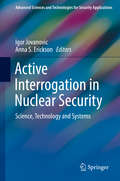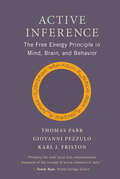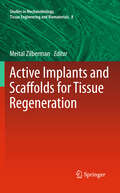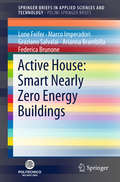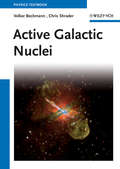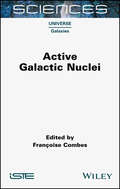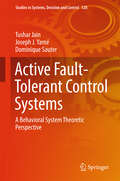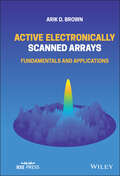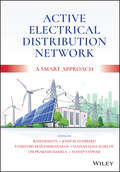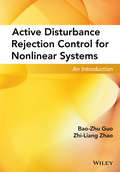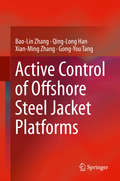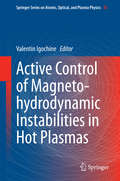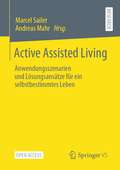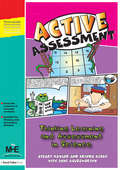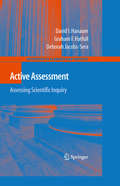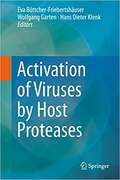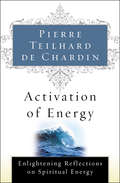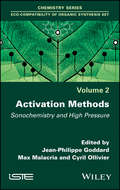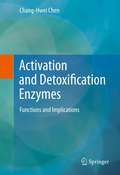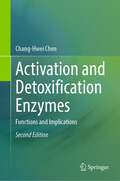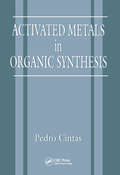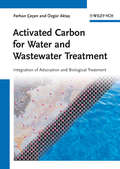- Table View
- List View
Active Interrogation in Nuclear Security: Science, Technology and Systems (Advanced Sciences and Technologies for Security Applications)
by Igor Jovanovic Anna S. EricksonThis volume constitutes the state-of-the-art in active interrogation, widely recognized as indispensable methods for addressing current and future nuclear security needs. Written by a leading group of science and technology experts, this comprehensive reference presents technologies and systems in the context of the fundamental physics challenges and practical requirements. It compares the features, limitations, technologies, and impact of passive and active measurement techniques; describes radiation sources for active interrogation including electron and ion accelerators, intense lasers, and radioisotope-based sources; and it describes radiation detectors used for active interrogation. Entire chapters are devoted to data acquisition and processing systems, modeling and simulation, data interpretation and algorithms, and a survey of working active measurement systems. Active Interrogation in Nuclear Security is structured to appeal to a range of audiences, including graduate students, active researchers in the field, and policy analysts.The first book devoted entirely to active interrogationPresents a focused review of the relevant physicsSurveys available technologyAnalyzes scientific and technology trends Provides historical and policy context Igor Jovanovic is a Professor of Nuclear Engineering and Radiological Sciences at the University of Michigan and has previously also taught at Penn State University and Purdue University. He received his Ph.D. from University of California, Berkeley and worked as physicist at Lawrence Livermore National Laboratory. Dr. Jovanovic has made numerous contributions to the science and technology of radiation detection, as well as the radiation sources for use in active interrogation in nuclear security. He has taught numerous undergraduate and graduate courses in areas that include radiation detection, nuclear physics, and nuclear security. At University of Michigan Dr. Jovanovic is the director of Neutron Science Laboratory and is also associated with the Center for Ultrafast Optical Science. Anna Erickson is an Assistant Professor in the Nuclear and Radiological Engineering Program of the G.W. Woodruff School of Mechanical Engineering at Georgia Institute of Technology. Previously, she was a postdoctoral researcher in the Advanced Detectors Group at Lawrence Livermore National Laboratory. Dr. Erickson received her PhD from Massachusetts Institute of Technology with a focus on radiation detection for active interrogation applications. Her research interests focus on nuclear non-proliferation including antineutrino analysis and non-traditional detector design and characterization. She teaches courses in advanced experimental detection for reactor and nuclear nonproliferation applications, radiation dosimetry and fast reactor analysis.
Active Inference: The Free Energy Principle in Mind, Brain, and Behavior
by Thomas Parr Karl J. Friston Giovanni PezzuloThe first comprehensive treatment of active inference, an integrative perspective on brain, cognition, and behavior used across multiple disciplines. Active inference is a way of understanding sentient behavior—a theory that characterizes perception, planning, and action in terms of probabilistic inference. Developed by theoretical neuroscientist Karl Friston over years of groundbreaking research, active inference provides an integrated perspective on brain, cognition, and behavior that is increasingly used across multiple disciplines including neuroscience, psychology, and philosophy. Active inference puts the action into perception. This book offers the first comprehensive treatment of active inference, covering theory, applications, and cognitive domains. Active inference is a &“first principles&” approach to understanding behavior and the brain, framed in terms of a single imperative to minimize free energy. The book emphasizes the implications of the free energy principle for understanding how the brain works. It first introduces active inference both conceptually and formally, contextualizing it within current theories of cognition. It then provides specific examples of computational models that use active inference to explain such cognitive phenomena as perception, attention, memory, and planning.
Active Implants and Scaffolds for Tissue Regeneration (Studies in Mechanobiology, Tissue Engineering and Biomaterials #8)
by Meital ZilbermanActive implants are actually drug or protein-eluting implants that induce healing effects, in addition to their regular task, such as support. This effect is achieved by controlled release of the active agent to the surrounding tissue. This book will give a broad overview of biomaterial platforms used as basic elements of drug-eluting implants. It will include mainly coatings for vascular stents with controlled release of antiproliferative agents, wound dressings with controlled release of antibacterial agents, drug-eluting vascular grafts, protein-eluting scaffolds for tissue regeneration, drug-eluting platforms for dental and other applications. Thus, both internal and external implants are described. The drug-eluting implants will be described in terms of matrix formats and polymers, incorporated drugs and their release profiles from the implants, as well as implant functioning. Smart polymeric systems, such as crosslinked poly-lactones, thermo and pH-sensitive hydrogels and poly(amido-amines), as well as novel basic structural elements, such as composite fibers and films, and nanostructures will be thoroughly described. The effect of the processing parameters on the microstructure and on the resulting drug release profiles, mechanical and physical properties, and other relevant properties, will be emphasized. The described new biomaterials approaches for active implants enhance the tools available for creating clinically important biomedical applications.
Active House: Smart Nearly Zero Energy Buildings (SpringerBriefs in Applied Sciences and Technology)
by Lone Feifer Marco Imperadori Graziano Salvalai Arianna Brambilla Federica BrunoneThe book provides an overview of the Active House (AH) vision, intended as a building design method “beyond” the passive approach for buildings of the future that will be more and more connected, smart and innovative. It offers a novel philosophical design approach in which buildings, new or renovated, are in balance with natural, renewable energies and become “concentrators-distributors” of energies instead of being consumers of resources. The book is composed of five chapters, providing information on fundamental aspects of innovations toward resource-efficient buildings, as well as case studies presenting the concept in practice. It demonstrates that a completely new design approach is possible, and that a turning point has been reached. Lastly, it shows how the AH Alliance, along with designers, institutions, industries and academies, is bringing a breath of fresh air to the world of construction.
Active Galactic Nuclei
by Volker Beckmann Chris ShraderActive Galactic Nuclei This AGN textbook gives an overview on the current knowledge of the Active Galacitc Nuclei phenomenon. The spectral energy distribution will be discussed, pointing out what can be observed in different wavebands. The different physical models are presented together with formula important for the understanding of AGN physics. Furthermore, the authors discuss the AGN with respect to its environment, host galaxy, feedback in galaxies and in clusters of galaxies, variability, etc. and finally the cosmological evolution of the AGN phenomenon. This book includes phenomena based on new results in the X-Ray and gamma-ray domain from new telescopes such as Chandra, XMM-Newton, the Fermi Gamma-Ray Space Telescope, and the VHE regime not mentioned so far in AGN books. Those and other new developments as well as simulations of AGN merging events and formations, enabled through latest super-computing capabilities. From the contents: The observational picture of AGN Radiative processes The central engine AGN types and unification AGN through the electromagnetic spectrum AGN variability Environment Quasars and cosmology Formation, evolution and the ultimate fate of AGN What we do not know (yet)
Active Galactic Nuclei
by Françoise CombesAll galaxies host a super-massive black hole in their center. These black holes grow their mass in symbiosis with their host galaxy and moderate their star formation. When matter is driven towards the nucleus, an accretion disk is formed to transfer angular momentum and considerable energy is released when the material falls into the black hole: this is the phenomenon of active galactic nuclei (AGN). A nucleus can shine one thousand times more brightly than the entire galaxy with its 200 billion stars. The nuclear activity can take many forms, from very powerful quasars to more ordinary Seyfert galaxies, passing by radio-galaxies, which eject a collimated plasma at ten times the radius of the galaxy.This book examines all of these manifestations and presents a unified view. When two galaxies merge, a binary black hole is formed and the two black holes will spiral inwards and merge, emitting long gravitational waves, which could be detected by the future LISA satellite.
Active Fault-Tolerant Control Systems: A Behavioral System Theoretic Perspective (Studies in Systems, Decision and Control #128)
by Tushar Jain Joseph J. Yamé Dominique SauterThe book introduces novel algorithms for designing fault-tolerant control (FTC) systems using the behavioral system theoretic approach, and presents a demonstration of successful novel FTC mechanisms on several benchmark examples. The authors also discuss a new transient management scheme, which is an essential requirement for the implementation of active FTC systems, and two data-driven methodologies that are broadly classified as active FTC systems: the projection-based approach and the online-redesign approach. These algorithms do not require much a priori information about the plant in real-time, and in addition this novel implementation of active FTC systems circumvents various weaknesses induced by using a diagnostic module in real-time. The book provides graduate students taking masters and doctoral courses in mathematics, control, and electrical engineering an excellent stepping-stone for their research. It also appeals to practitioners interested to apply innovative fail-safe control techniques.
Active Electronically Scanned Arrays: Fundamentals and Applications (IEEE Press)
by Arik D. BrownIn Active Electronically Scanned Arrays: Fundamentals and Applications, electromagnetics expert Dr. Arik D. Brown delivers a foundational treatment of active electronically scanned arrays (AESAs) ideal for engineering students and professionals. The distinguished author provides an overview of the primary subsystems of an AESA and detailed explanations of key design concepts and fundamentals for subsystems, including antenna array elements, transmit/receive modules, and beamformers. Performance results for various AESA architectures often found in industry, including analog, subarrayed, and digital beamforming AESAs, are discussed. With a focus on practical knowledge and applications, Active Electronically Scanned Arrays: Fundamentals and Applications offers an accessible overview of a technology critical to the implementation of collision avoidance in cars, air surveillance radar, communication antennas, and defense technologies. The book also includes: A thorough introduction to AESAs, including a top-level block diagram view and explanations of key components and subsystems Detailed explanations of the impact of AESAs on mission applications including Radar, Electronic Attack (EA), Electronic Support Measures (ESM), SIGINT and Communications Comprehensive explorations of antenna array elements, transmit/receive modules, and beamformers including their purpose, functions, and practical design considerations In-depth examinations of AESA architecture performance for current and future systems Utility of AESAs for implementing adaptive beamforming for Electronic Counter-Countermeasures (ECCM) Perfect for electrical engineers working with active electronically scanned arrays, electronic warfare technologies, radar, or communications, Active Electronically Scanned Arrays: Fundamentals and Applications will also prove to be an invaluable resource for defense students undertaking military education and training.
Active Electrical Distribution Network: A Smart Approach
by Baseem Khan Josep M. Guerrero Sanjeevikumar Padmanaban Hassan Haes Alhelou Om Prakash Mahela Sudeep TanwarACTIVE ELECTRICAL DISTRIBUTION NETWORK Discover the major issues, solutions, techniques, and applications of active electrical distribution networks with this edited resourceActive Electrical Distribution Network: A Smart Approach delivers a comprehensive and insightful guide dedicated to addressing the major issues affecting an often-overlooked sector of the electrical industry: electrical distribution. The book discusses in detail a variety of challenges facing the smart electrical distribution network and presents a detailed framework to address these challenges with renewable energy integration.The book offers readers fulsome analyses of active distribution networks for smart grids, as well as active control approached for distributed generation, electric vehicle technology, smart metering systems, smart monitoring devices, smart management systems, and various storage systems. It provides a treatment of the analysis, modeling, and implementation of active electrical distribution systems and an exploration of the ways professionals and researchers from academia and industry attempt to meet the significant challenges facing them.From smart home energy management systems to approaches for the reconfiguration of active distribution networks with renewable energy integration, readers will also enjoy:A thorough introduction to electrical distribution networks, including conventional and smart networksAn exploration of various existing issues related to the electrical distribution networkAn examination of the importance of harmonics mitigation in smart distribution networks, including active filtersA treatment of reactive power compensation under smart distribution networks, including techniques like capacitor banks and smart devicesAn analysis of smart distribution network reliability assessment and enhancementPerfect for professionals, scientists, technologists, developers, designers, and researchers in smart grid technologies, security, and information technology, Active Electrical Distribution Network: A Smart Approach will also earn a place in the libraries of policy and administration professionals, as well as those involved with electric utilities, electric policy development, and regulating authorities.
Active Disturbance Rejection Control for Nonlinear Systems: An Introduction
by Bao-Zhu Guo Zhi-Liang ZhaoA concise, in-depth introduction to active disturbance rejection control theory for nonlinear systems, with numerical simulations and clearly worked out equations Provides the fundamental, theoretical foundation for applications of active disturbance rejection control Features numerical simulations and clearly worked out equations Highlights the advantages of active disturbance rejection control, including small overshooting, fast convergence, and energy savings
Active Control of Offshore Steel Jacket Platforms
by Gong-You Tang Xian-Ming Zhang Qing-Long Han Bao-Lin Zhang<p>Offshore platforms are widely used to explore, drill, produce, store and transport ocean resources, and are usually subjected to environmental loading, which can lead to deck facility failure and platform fatigue failure, inefficient operation and even crew discomfort. In order to ensure the reliability and safety of offshore platforms, it is important to explore effective ways of suppressing the vibration of offshore platforms. <p>This book provides a brief overview of passive, semi-active and active control schemes to deal with vibration of offshore platforms. It then comprehensively and systematically discusses the recent advances in active systems with optimal, sliding model, delayed feedback and network-based control. Intended for readers interested in vibration control and ocean engineering, it is particularly useful for researchers, engineers, and graduate students in the fields of system and control community, vibration control, ocean engineering, as well as electrical and electronic engineering.</p>
Active Control of Magneto-hydrodynamic Instabilities in Hot Plasmas (Springer Series on Atomic, Optical, and Plasma Physics #83)
by Valentin IgochineDuring the past century, world-wide energy consumption has risen dramatically, which leads to a quest for new energy sources. Fusion of hydrogen atoms in hot plasmas is an attractive approach to solve the energy problem, with abundant fuel, inherent safety and no long-lived radioactivity. However, one of the limits on plasma performance is due to the various classes of magneto-hydrodynamic instabilities that may occur. The physics and control of these instabilities in modern magnetic confinement fusion devices is the subject of this book. Written by foremost experts, the contributions will provide valuable reference and up-to-date research reviews for "old hands" and newcomers alike.
Active Chemistry
by Arthur EisenkraftThe highlighting features of this Chemistry text book are: Scenario, Chapter Challenge, Criteria, What Do You Think?, Investigate, Chem Talk, Chem Words, Checking Up, Reflecting on the Activity and the Challenge, Chemistry to Go, Preparing for the Chapter Challenge, Challenge Assessment, Chemistry at Work and Photos and Illustrations.
Active Chemistry
by Arthur Eisenkraft Gary Freebury American Institute of Chemical Engineers Staff It'S About TimeActive Chemistry makes learning chemistry relevant, fun, and exciting. Chemistry is involved in every aspect of your life - from the way your body works to the things you like to do.
Active Biology
by Ruta Demery Robert RitterActive Biology has fascinating challenges that ask you to use your creativity, interests, and expertise to complete challenges in the same way professionals do. You will learn about the incredible variety of organisms that inhabit the earth and how they have adapted to their environment. You will investigate competition among organisms and the process of natural selection. You will discover the factors that affect population size. And you will understand that the extinction of one organism can affect an entire ecosystem.
Active Assisted Living: Anwendungsszenarien und Lösungsansätze für ein selbstbestimmtes Leben
by Marcel Sailer Andreas MahrIn dem vorliegenden Open-Access-Buch identifizieren Studierende und Lehrende interprofessionell Entwicklungen und Problemfelder der Assistiven Technologien. Diese halten zunehmend Einzug ins Leben versorgungsbedürftiger, häufig älterer Menschen. Nach einigen Jahren der Entwicklung kann konstatiert werden, dass der Transfer von Entwicklung zur Anwendung im Alltag infolge unterschiedlicher Perspektiven und Zielsetzungen nur unzureichend stattfindet. Die Beitragsautoren bieten kreative Lösungsansätze, die zu einer nachhaltigen Umsetzung führen sollen.Dies ist ein Open-Access-Buch.
Active Assessment for Science: Thinking, Learning and Assessment in Science
by Stuart Naylor Brenda Keogh Anne GoldsworthyEverybody seems to be talking about assessment for learning. This book shows how to do it. Using a highly creative approach it explains in detail how assessment, thinking and learning can be integrated in science lessons. More than 30 different assessment techniques are described, with each one illustrated for two different age ranges.Concise teachers' notes for each technique explain:what the approach ishow you use it for assessmenthow you can manage it in the classroomhow it helps with learning.Electronic versions of the activities are provided on the accompanying downloadable resources.
Active Assessment: Assessing Scientific Inquiry (Mentoring in Academia and Industry #2)
by David I. Hanauer Debbie Jacobs-Sera Graham F. HatfullThe book is designed to provide a theoretical introduction to the field of active assessment, a practical guide to the development of assessment tools for scientific inquiry and a case study of a specific development and implementation process of assessment in a scientific inquiry program. As currently designed the book would have two sections: the first, theoretical and practical developing the concepts of how assessment is developed and implemented and the second section, a case study from research work conducted in the outreach program of the Bacteriophage Institute of Pittsburgh. The book is designed for a wide market of scientists involved in scientific education laboratory work. As with the original research project, this book breaks new ground in the area of scientific education and assessment and at this current time there is no book or research monograph that explicates a serious, comprehensive approach to the assessment of scientific inquiry. It is important to note that according to all the central bodies involved in science education (see the National Research Council's standards for science education) that the use of scientific inquiry is the preferred method of teaching science. Accordingly a book of this type should provide an important service for all active scientific inquiry programs in that it presents for the first time a concept and method for assessing scientific inquiry on the undergraduate and graduate levels. This book could provide an interesting answer to this situation of a required educational context without developed methodologies for evaluation.
Activation of Viruses by Host Proteases
by Eva Böttcher-Friebertshäuser Wolfgang Garten Hans Dieter KlenkPresents recent findings on this topic.<P><P> Deals with all aspects of the role of proteases in virus activation.<P> Explores the topic from different points of view.<P>This book will give an overview on viruses undergoing proteolytic activation through host proteases. The chapters will be organized in three themed parts, the first part describing respective viruses and their characteristics in detail. In the second part the molecular and cellular biology of the proteases involved as well as their physiological functions will be further explored. The third part will contain a chapter on protease inhibitors that are promising tools for antiviral therapy.<P> This book will engage scholars in virology and medical microbiology as well as researchers with an interest in enzymology and protein structure and function relationship.
Activation of Energy: Enlightening Reflections on Spiritual Energy
by Pierre Teilhard de ChardinThe renowned Jesuit thinker explores science, theology, and the course of human evolution. Following in the footsteps of his earlier works, this collection of essays from Pierre Teilhard de Chardin brings greater clarity to the stunning potential of human energy if it is properly channeled, as he describes, &“upward and outward.&” While energy wrongly directed appears as depression, drug addiction, and violence, this legendary scholar—a priest who earned a doctorate in geology and studied the sciences extensively—promises that spiritual energy channeled correctly will become a true force in the universe, far outdistancing the potential of technological advance. &“Like other great visionary poets—Blake, Hopkins, Yeats—Teilhard engages the reader both intellectually and sensually.&” —The Washington Post Book World
Activation Methods: Sonochemistry and High Pressure
by Jean-Philippe Goddard Max Malacria Cyril OllivierActivation Methods examines recent improvements in the utilization of ultrasonic waves and pressurized gases to generate reactions. A straightforward method to use, sonochemistry allows chemical reactions to be carried out under ultrasound without the need for external heat, reagents or catalysts – leading to high yields and the production of a minimum amount of waste. This book presents an overview of the main applications of sonochemistry in green organic chemistry, with an emphasis on texts published within the last few years. High-pressure chemical reactions offer innovative solutions to problems relating to synthesis. They allow access to new products and a further understanding of reaction mechanisms. This book presents the characteristics of hyperbaric activation, which allow the integration of an arsenal of tools for green chemistry, such as the lowering of energy costs and of by-products, as well as the possibility of using substrates that are sterically congested and generally inert.
Activation and Detoxification Enzymes: Functions and Implications
by Chang-Hwei ChenHumans are exposed to foreign compounds such as drugs, household products and environmental chemicals by swallowing or breathing. Also, food is considered a foreign compound. Such foreign compounds can be non-essential and non-functional to life, and commonly are referred to as xenobiotics. Some xenobiotics are not toxic; however, many of them are potentially toxic or become toxic after conversion to metabolic intermediates. A considerable number of foreign compounds belong to non-polar, lipophilic substances. Lipophilic compounds are not soluble in water. Metabolic conversion of lipophilic foreign compounds to facilitate their removal from the body is essentially carried out by biochemical reactions catalyzed by two classes of metabolizing enzymes, namely, activation enzymes and detoxification enzymes. Activation enzyme-catalyzed functionalization reaction introduces a functional group to a lipophilic compound. Functionalization modifies many foreign compounds to form reactive intermediates capable of interacting with cellular components (proteins, DNA and lipids), leading to a variety of conditions for diseases. Functionalized compounds are further metabolized through detoxification enzyme-catalyzed reactions, which result in an increase in the solubility of parent compounds and an inactivation of metabolic intermediates, thus facilitating their excretion from the body. To minimize the exposure of potentially toxic metabolic intermediates, it is essential to keep them at a minimum level. Extensive investigations have revealed that foreign compound-metabolizing enzymes exhibit genetic polymorphisms. Variations in their activities can produce different results as to the susceptibility to potential toxic effects. Moreover, the expressions of activation enzymes and detoxification enzymes are inducible. A number of chemical compounds are capable of acting as modulators for these two classes of enzymes. These findings have lead to the proposal of modulating metabolizing enzymes as a useful approach for human health benefits. Importantly, many of these chemical compounds are present in human daily diets. There are many advances that have been made in the past decades towards the understanding of functions and implications of activation enzymes and detoxification enzymes. An organized, concise overview is needed for the readers who are initially exposed to this important subject, particularly for students and researchers in the areas of biomedical sciences, biochemistry, nutrition, pharmacology and chemistry. This book is intended to serve this purpose as an introduction to the subject. Furthermore, major topics in the book, excluding catalytic reactions and structural properties, may have interest to other readers who have knowledge of basic sciences and understanding enzyme related information. The book discusses subjects associated with foreign compound metabolizing enzymes with emphasis on biochemical aspects, including lipophilic foreign compounds, catalytic properties, reactive intermediates, biomedical and biochemical effects, genetic polymorphisms, enzyme inducibility, enzyme modulation for health benefits, dietary related enzyme modulators, and structural characteristics of enzyme inducers.
Activation and Detoxification Enzymes: Functions and Implications
by Chang-Hwei ChenThis book discusses the many advances in the understanding of the functions and implications of activation and detoxification enzymes. This organized, concise overview will meet the needs of those who are initially exposed to this important subject, particularly for students and researchers in the areas of biomedical sciences, biochemistry, nutrition, pharmacology, and chemistry. The book will also be valuable to advanced researchers. The book discusses subjects associated with foreign-compound-metabolizing enzymes with emphasis on biochemical aspects, including lipophilic foreign compounds, activation and detoxification enzymes, metabolic enzyme catalytic properties, reactive metabolic intermediates, biomedical and biochemical effects, genetic polymorphisms, enzyme inducibility, enzyme modulation for health benefits, dietary-related enzyme modulators, and structural characteristics of enzyme inducers. This new edition is updated throughout andfeatures completely new chapters on Oxidative and Electrophilic Stresses, Metabolite- Mediated Disease Conditions, and Defense Mechanism: Nrf2-ARE Pathway.
Activated Metals in Organic Synthesis (New Directions In Organic And Biological Chemistry Ser.)
by P. CintasActivated Metals in Organic Synthesis discusses fundamental principles of the generation of activated, highly reactive metals, and their applications in organic synthesis. Following an introductory chapter on basic forms of metals the chapters in Part 1 are devoted to common strategies utilized for the preparation of active metals. These strategies include vaporization and subsequent co-condensation of metal atoms, in addition to depassivating methods employed commonly in laboratory syntheses. Chapters in Part 2 discuss relevant organic transformations in which metal activation plays a crucial role. Specific topics covered include metal-induced reductive methods; pinacolic, Reformatsky-, and Barbier-type reactions; McMurry ketone-olefin coupling; and the Bernet-Vasella reaction. Each chapter is followed by literature citations ranging from specific references to significant reviews. Many structural formulas are provided, making it easy to follow each synthesis. The book will be an important reference for students, organic chemists, and researchers in all areas of organometallic chemistry.
Activated Carbon for Water and Wastewater Treatment: Integration of Adsorption and Biological Treatment
by Ferhan Cecen Özgür AktasThis monograph provides comprehensive coverage of technologies which integrate adsorption and biological processes in water and wastewater treatment. The authors provide both an introduction to the topic as well as a detailed discussion of theoretical and practical considerations. After a review of the basics involved in the chemistry, biology and technology of integrated adsorption and biological removal, they discuss the setup of pilot- and full-scale treatment facilities, covering powdered as well as granular activated carbon. They elucidate the factors that influence the successful operation of integrated systems. Their discussion on integrated systems expands from the effects of environmental to the removal of various pollutants, to regeneration of activated carbon, and to the analysis of such systems in mathematical terms. The authors conclude with a look at future needs for research and develoment. A truly valuable resource for environmental engineers, environmental and water chemists, as well as professionals working in water and wastewater treatment.
